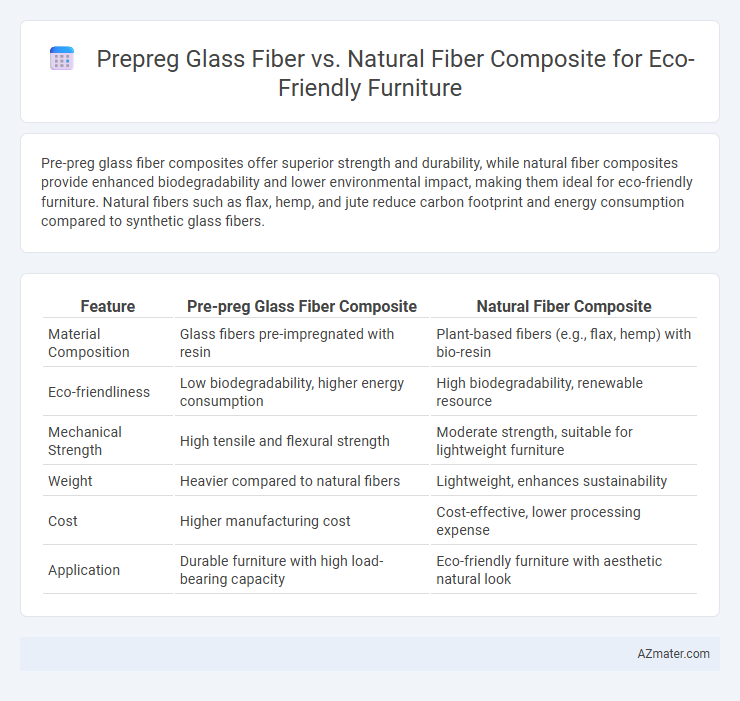Pre-preg glass fiber composites offer superior strength and durability, while natural fiber composites provide enhanced biodegradability and lower environmental impact, making them ideal for eco-friendly furniture. Natural fibers such as flax, hemp, and jute reduce carbon footprint and energy consumption compared to synthetic glass fibers.
Table of Comparison
| Feature | Pre-preg Glass Fiber Composite | Natural Fiber Composite |
|---|---|---|
| Material Composition | Glass fibers pre-impregnated with resin | Plant-based fibers (e.g., flax, hemp) with bio-resin |
| Eco-friendliness | Low biodegradability, higher energy consumption | High biodegradability, renewable resource |
| Mechanical Strength | High tensile and flexural strength | Moderate strength, suitable for lightweight furniture |
| Weight | Heavier compared to natural fibers | Lightweight, enhances sustainability |
| Cost | Higher manufacturing cost | Cost-effective, lower processing expense |
| Application | Durable furniture with high load-bearing capacity | Eco-friendly furniture with aesthetic natural look |
Introduction to Eco-Friendly Furniture Materials
Eco-friendly furniture materials prioritize sustainability by utilizing renewable and recyclable resources such as pre-preg glass fiber composites and natural fiber composites. Pre-preg glass fiber offers high strength and durability with reduced resin usage, while natural fiber composites, derived from flax, hemp, or jute, provide biodegradability and lower environmental impact. These materials support eco-conscious manufacturing practices, reducing carbon footprints and promoting healthier living environments.
Overview of Pre-preg Glass Fiber Composites
Pre-preg glass fiber composites consist of glass fibers pre-impregnated with a resin matrix, offering superior strength-to-weight ratios and enhanced durability for eco-friendly furniture applications. These composites provide consistent fiber-to-resin ratios, resulting in improved mechanical properties and reduced manufacturing defects compared to traditional wet lay-up methods. The controlled curing process of pre-pregs enables high-quality, lightweight furniture components that support sustainable design by extending product life and minimizing waste.
Basics of Natural Fiber Composites
Natural fiber composites combine organic fibers such as flax, jute, or hemp with polymer matrices, offering a sustainable alternative to traditional materials. These composites are valued for their low density, biodegradability, and reduced environmental impact compared to synthetic fibers. Mechanical properties like tensile strength and durability vary depending on fiber type and treatment, making material selection critical for eco-friendly furniture applications.
Environmental Impact Comparison
Pre-preg glass fiber composites exhibit higher durability and strength but generate significant carbon emissions and non-biodegradable waste during production and disposal. Natural fiber composites, such as those made from hemp or flax, offer lower environmental impact due to renewable sources, biodegradability, and reduced energy consumption in manufacturing. Life cycle assessments demonstrate that natural fiber composites significantly decrease greenhouse gas emissions and ecological footprints compared to traditional glass fiber for eco-friendly furniture applications.
Mechanical Properties and Durability
Pre-preg glass fiber composites exhibit superior mechanical properties, including higher tensile strength and stiffness compared to natural fiber composites, making them ideal for load-bearing furniture applications. Natural fiber composites, while offering enhanced biodegradability and lower environmental impact, generally demonstrate lower durability and are more susceptible to moisture absorption and degradation over time. Combining eco-friendly resin matrices with natural fibers can improve durability, but pre-preg glass fiber composites remain the preferred choice for furniture requiring long-term structural integrity.
Manufacturing Processes and Sustainability
Pre-preg glass fiber composites involve a manufacturing process where glass fibers are pre-impregnated with resin, ensuring controlled fiber volume and superior mechanical properties, but requiring energy-intensive curing in autoclaves. Natural fiber composites utilize fibers like flax or hemp combined with bio-resins through simpler, low-energy processes such as compression molding or hand lay-up, significantly reducing carbon footprint and waste. Sustainability benefits of natural fiber composites include biodegradability, renewable sourcing, and lower embodied energy compared to the synthetic, non-biodegradable nature and higher environmental impact of pre-preg glass fiber composites.
Cost Analysis and Market Availability
Pre-preg glass fiber composites exhibit higher initial costs compared to natural fiber composites due to advanced manufacturing processes and raw material expenses. Natural fiber composites offer cost advantages with abundant, renewable resources and simpler processing, making them more accessible for eco-friendly furniture production. Market availability favors natural fiber composites, driven by growing consumer demand for sustainable materials and widespread agricultural supply chains.
Design Flexibility and Aesthetics
Pre-preg glass fiber composites offer superior design flexibility with consistent surface finish and high strength-to-weight ratio, making them ideal for sleek, modern furniture designs. Natural fiber composites provide a unique, organic aesthetic with customizable textures and colors, enhancing the eco-friendly appeal of the furniture. Balancing the high-performance properties of glass fibers with the sustainable, renewable qualities of natural fibers enables innovative, visually appealing furniture solutions.
End-of-Life Options: Recyclability and Biodegradability
Pre-preg glass fiber composites offer limited recyclability due to their thermoset resin matrix, resulting in challenges at the end-of-life stage and often leading to landfill disposal. Natural fiber composites, made from renewable resources like hemp or flax combined with biodegradable resins, provide superior biodegradability and more sustainable disposal options, including composting and natural degradation. The eco-friendly furniture industry benefits from natural fiber composites by reducing environmental impact through easier end-of-life management and enhanced circular economy alignment.
Choosing the Best Composite for Eco-Friendly Furniture
Pre-preg glass fiber composites offer superior strength and durability but involve higher energy consumption during production, impacting their eco-friendliness compared to natural fiber composites like flax or hemp, which provide lightweight, biodegradable, and renewable options. Natural fiber composites reduce carbon footprint significantly due to sustainable sourcing and lower processing emissions while maintaining adequate mechanical properties for furniture applications. Selecting the best composite for eco-friendly furniture requires balancing performance demands with environmental impact, favoring natural fiber composites for truly sustainable design solutions.

Infographic: Pre-preg Glass Fiber vs Natural Fiber Composite for Eco-friendly Furniture
 azmater.com
azmater.com